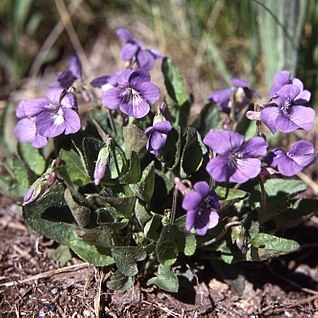Plants perennial, acaulescent, not stoloniferous, 5–15 cm; rhizome slender, becoming thick and fleshy with age. Leaves basal, 4–7, ascending to erect; stipules lanceolate, margins entire or fimbriate, apex acute; petiole 2–25 cm, usually glabrous; blade usually grayish green or purplish green abaxially, unlobed, ovate, reniform, or broadly reniform to orbiculate, 1–7 × 1–7 cm, somewhat fleshy, base broadly cordate or reniform to ± truncate, margins crenate to serrate, ciliate or eciliate, apex acute to obtuse or rounded, surfaces usually glabrous, rarely sparsely pubescent. Peduncles 3–25 cm, usually glabrous. Flowers: sepals ovate, margins usually eciliate, auricles 1–2 mm; petals deep bluish violet on both surfaces, lower 3 white basally and darker violet-veined, lateral 2 bearded, upper 2 sometimes sparsely bearded, lowest densely bearded or beardless, 10–28 mm, spur same color as petals, gibbous, 2–3 mm; style head beardless; cleistogamous flowers on erect to ascending peduncles. Capsules ovoid, 5–10 mm, glabrous. Seeds beige to brown or dark brown, 1.5–2.5 mm. 2n = 54.
More
Lvs glabrous, relatively small, the later ones not notably larger than the earlier ones, seldom as much as 7 cm wide; fls often elevated somewhat above the lvs, narrower and more elongate than in no. 5 [Viola sororia Willd.], the relatively narrow lateral pet directed forward at an angle, tapering to an almost clawed base; spurred pet bearded or not; 2n=54; otherwise much like no. 5 [Viola sororia Willd.]. Mainly in the w. cordillera, but extending e. in cold, wet places (often with a high pH) to ne. U.S. (Mich., Wis., n. N.Y., and New Engl.) and se. Can. May–July.


